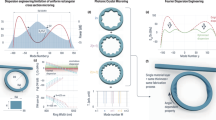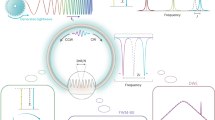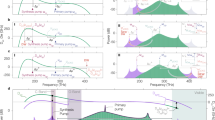Abstract
Nonlinear wave mixing in optical microresonators offers new perspectives to generate compact optical-frequency microcombs, which enable an ever-growing number of applications. Microcombs exhibit a spectral profile that is primarily determined by their microresonator’s dispersion. One example is the sech2 spectrum of dissipative Kerr solitons under anomalous group-velocity dispersion. Here we introduce an inverse-design approach to spectrally shape microcombs, by optimizing an arbitrary meta-dispersion in a resonator. By incorporating the system’s governing equation into a genetic algorithm, we are able to efficiently identify a dispersion profile that produces a microcomb closely matching a user-defined target spectrum, such as spectrally flat combs or near-Gaussian pulses. We show a concrete implementation of these intricate optimized dispersion profiles, using selective bidirectional-mode hybridization in photonic-crystal resonators. Moreover, we fabricate and explore several microcomb generators with such flexible ‘meta’ dispersion control. Their dispersion is not only controlled by the waveguide composing the resonator, but also by a corrugation inside the resonator, which geometrically controls the spectral distribution of the bidirectional coupling in the resonator. This approach provides programmable mode-by-mode frequency splitting and thus greatly increases the design space for controlling the nonlinear dynamics of optical states such as Kerr solitons.
This is a preview of subscription content, access via your institution
Access options
Access Nature and 54 other Nature Portfolio journals
Get Nature+, our best-value online-access subscription
$29.99 / 30 days
cancel any time
Subscribe to this journal
Receive 12 print issues and online access
$209.00 per year
only $17.42 per issue
Buy this article
- Purchase on Springer Link
- Instant access to full article PDF
Prices may be subject to local taxes which are calculated during checkout






Similar content being viewed by others
Data availability
The data and code used to produce the figures of this manuscript are available on Zenodo at https://doi.org/10.5281/zenodo.7998103.
Code availability
The code for the genetic algorithm implementation used to perform the dispersion optimization is available at https://github.com/ErwanLucas/inverseLLE.
References
Kippenberg, T. J., Gaeta, A. L., Lipson, M. & Gorodetsky, M. L. Dissipative Kerr solitons in optical microresonators. Science 361, eaan8083 (2018).
Lugiato, L. A. & Lefever, R. Spatial dissipative structures in passive optical systems. Phys. Rev. Lett. 58, 2209–2211 (1987).
Coen, S., Randle, H. G., Sylvestre, T. & Erkintalo, M. Modeling of octave-spanning Kerr frequency combs using a generalized mean-field Lugiato-Lefever model. Opt. Lett. 38, 37–39 (2013).
Spencer, D. T. et al. An optical-frequency synthesizer using integrated photonics. Nature 557, 81–85 (2018).
Marin-Palomo, P. et al. Microresonator-based solitons for massively parallel coherent optical communications. Nature 546, 274–279 (2017).
Trocha, P. et al. Ultrafast optical ranging using microresonator soliton frequency combs. Science 359, 887–891 (2018).
Suh, M.-G. & Vahala, K. J. Soliton microcomb range measurement. Science 359, 884–887 (2018).
Riemensberger, J. et al. Massively parallel coherent laser ranging using a soliton microcomb. Nature 581, 164–170 (2020).
Drake, T. E. et al. Terahertz-rate Kerr-microresonator optical clockwork. Phys. Rev. X 9, 031023 (2019).
Leo, F. et al. Temporal cavity solitons in one-dimensional Kerr media as bits in an all-optical buffer. Nat. Photon. 4, 471–476 (2010).
Herr, T. et al. Temporal solitons in optical microresonators. Nat. Photon. 8, 145–152 (2013).
Lorenc, D., Velic, D., Markevitch, A. & Levis, R. Adaptive femtosecond pulse shaping to control supercontinuum generation in a microstructure fiber. Opt. Commun. 276, 288–292 (2007).
Sigmund, O. On the usefulness of non-gradient approaches in topology optimization. Struct. Multidiscipl. Optim. 43, 589–596 (2011).
Jensen, J. & Sigmund, O. Topology optimization for nano-photonics. Laser Photon. Rev. 5, 308–321 (2011).
Genty, G. et al. Machine learning and applications in ultrafast photonics. Nat. Photon. 15, 91–101 (2021).
Joannopoulos, J. D., Villeneuve, P. R. & Fan, S. Photonic crystals: putting a new twist on light. Nature 386, 143–149 (1997).
Molesky, S. et al. Inverse design in nanophotonics. Nat. Photon. 12, 659–670 (2018).
Yu, Z., Cui, H. & Sun, X. Genetically optimized on-chip wideband ultracompact reflectors and Fabry-Perot cavities. Photon. Res. 5, B15–B19 (2017).
Ahn, G. H. et al. Photonic inverse design of on-chip microresonators. ACS Photonics 9, 1875–1881 (2022).
Yu, S.-P. et al. Spontaneous pulse formation in edgeless photonic crystal resonators. Nat. Photon. 15, 461–467 (2021).
Lu, X., Rao, A., Moille, G., Westly, D. A. & Srinivasan, K. Universal frequency engineering tool for microcavity nonlinear optics: multiple selective mode splitting of whispering-gallery resonances. Photon. Res. 8, 1676 (2020).
Moille, G., Lu, X., Stone, J., Westly, D. & Srinivasan, K. Fourier synthesis dispersion engineering of photonic crystal microrings for broadband frequency combs. Commun. Phys. 6, 1–11 (2023).
Zhang, C., Kang, G., Wang, J., Pan, Y. & Qu, J. Inverse design of soliton microcomb based on genetic algorithm and deep learning. Opt. Express 30, 44395–44407 (2022).
Brasch, V. et al. Photonic chip-based optical frequency comb using soliton Cherenkov radiation. Science 351, 357–360 (2016).
Lobanov, V. E., Lihachev, G., Kippenberg, T. J. & Gorodetsky, M. Frequency combs and platicons in optical microresonators with normal GVD. Opt. Express 23, 7713–7721 (2015).
Yu, S.-P., Lucas, E., Zang, J. & Papp, S. B. A continuum of bright and dark-pulse states in a photonic-crystal resonator. Nat. Commun. 13, 3134 (2022).
Holland, J. H. Adaptation in Natural and Artificial Systems: An Introductory Analysis with Applications to Biology, Control and Artificial Intelligence (MIT Press, 1992).
Kumar, M., Husain, M., Upreti, N. & Gupta, D. Genetic algorithm: review and application. SSRN Electron. J. https://ssrn.com/abstract=3529843 (2010).
Coen, S. & Erkintalo, M. Universal scaling laws of Kerr frequency combs. Opt. Lett. 38, 1790–1792 (2013).
Godey, C., Balakireva, I. V., Coillet, A. & Chembo, Y. K. Stability analysis of the spatiotemporal Lugiato-Lefever model for Kerr optical frequency combs in the anomalous and normal dispersion regimes. Phys. Rev. A 89, 063814 (2014).
Helgason, Ó. B. et al. Dissipative solitons in photonic molecules. Nat. Photon. 15, 305–310 (2021).
Skryabin, D. V. Hierarchy of coupled mode and envelope models for bi-directional microresonators with Kerr nonlinearity. OSA Continuum 3, 1364–1375 (2020).
Jung, H. et al. Tantala Kerr nonlinear integrated photonics. Optica 8, 811–817 (2021).
Li, J., Lee, H., Yang, K. Y. & Vahala, K. J. Sideband spectroscopy and dispersion measurement in microcavities. Opt. Express 20, 26337 (2012).
Herr, T. et al. Mode spectrum and temporal soliton formation in optical microresonators. Phys. Rev. Lett. 113, 123901 (2014).
Herr, T. et al. Universal formation dynamics and noise of Kerr-frequency combs in microresonators. Nat. Photon. 6, 480–487 (2012).
Li, Q. et al. Stably accessing octave-spanning microresonator frequency combs in the soliton regime. Optica 4, 193–203 (2017).
Gao, M. et al. Probing material absorption and optical nonlinearity of integrated photonic materials. Nat. Commun. 13, 3323 (2022).
Ji, Q.-X. et al. Engineered zero-dispersion microcombs using CMOS-ready photonics. Optica 10, 279–285 (2023).
Wang, H. et al. Dirac solitons in optical microresonators. Light Sci. Appl. 9, 205 (2020).
Fan, S. Sharp asymmetric line shapes in side-coupled waveguide-cavity systems. Appl. Phys. Lett. 80, 908–910 (2002).
Gorodetsky, M. L., Pryamikov, A. D. & Ilchenko, V. S. Rayleigh scattering in high-Q microspheres. J. Opt. Soc. Am. B 17, 1051–1057 (2000).
Hansson, T., Modotto, D. & Wabnitz, S. On the numerical simulation of Kerr frequency combs using coupled mode equations. Opt. Commun. 312, 134–136 (2014).
Gnan, M. et al. Closure of the stop-band in photonic wire Bragg gratings. Opt. Express 17, 8830–8842 (2009).
Acknowledgements
E.L. acknowledges support from the Swiss National Science Foundation (SNSF) under contract no. 191705. This research was funded by the DARPA PIPES programme under HR0011-19-2-0016 and the AFOSR FA9550-20-1-0004 project no. 19RT1019 and NIST.
Author information
Authors and Affiliations
Contributions
E.L. implemented the optimization algorithm, performed the experiments and analysed the data. E.L. and S.-P.Y. contributed to the numerical simulations and resonators design. T.C.B. and D.R.C. fabricated the microresonators. E.L. wrote the manuscript, with input from all authors. S.B.P. supervised the project.
Corresponding authors
Ethics declarations
Competing interests
D.R.C. is a cofounder of Octave Photonics. The remaining authors declare no competing interests.
Peer review
Peer review information
Nature Photonics thanks Victor Torres-Company and the other, anonymous, reviewer(s) for their contribution to the peer review of this work.
Additional information
Publisher’s note Springer Nature remains neutral with regard to jurisdictional claims in published maps and institutional affiliations.
Extended data
Extended Data Fig. 1 PhC and mode splitting calibration.
Measured mode splitting of the target mode as a function of corrugation amplitude ρPhC (single frequency PhC), measured across 114 resonators. The inset shown an extended range of ρPhC.
Extended Data Fig. 2 Effect of distributing the PhC pattern along the ring perimeter.
(a) Measured mode splitting distribution with various amount of chirping applied to the corrugation pattern. The design target is the Gaussian distribution shown in black. (b-d) Spatial profiles of the designed corrugations. (a) Without chirp, the splitting distribution is distorted and even inverted. The effect is avoided by chirping the pattern.
Supplementary information
Supplementary Information
Supplementary sections 1-4 and Figs. 1–3.
Rights and permissions
Springer Nature or its licensor (e.g. a society or other partner) holds exclusive rights to this article under a publishing agreement with the author(s) or other rightsholder(s); author self-archiving of the accepted manuscript version of this article is solely governed by the terms of such publishing agreement and applicable law.
About this article
Cite this article
Lucas, E., Yu, SP., Briles, T.C. et al. Tailoring microcombs with inverse-designed, meta-dispersion microresonators. Nat. Photon. 17, 943–950 (2023). https://doi.org/10.1038/s41566-023-01252-7
Received:
Accepted:
Published:
Issue Date:
DOI: https://doi.org/10.1038/s41566-023-01252-7
This article is cited by
-
Synthetic reflection self-injection-locked microcombs
Nature Photonics (2024)
-
Integrated vortex soliton microcombs
Nature Photonics (2024)
-
Wavelength-accurate nonlinear conversion through wavenumber selectivity in photonic crystal resonators
Nature Photonics (2024)
-
Genetic algorithm-enhanced microcomb state generation
Communications Physics (2024)
-
Quiet point engineering for low-noise microwave generation with soliton microcombs
Communications Physics (2023)



